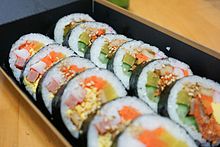Gimbap

sliced vegetable gimbap
|
|
| Place of origin | Korea |
|---|---|
| Main ingredients | Gim, bap |
| Variations | Chungmu-gimbap, samgak-gimbap |
| |
|
| Korean name | |
| Hangul | 김밥 |
|---|---|
| Revised Romanization | gimbap |
| McCune–Reischauer | kimbap |
| IPA | [kim.bap̚]~[kim.p͈ap̚] |
Gimbap (김밥) is a Korean dish made from steamed white rice (bap) and various other ingredients, rolled in gim (sheets of dried laver seaweed) and served in bite-size slices. Gimbap is often eaten during picnics or outdoor events, or as a light lunch, served with takuan or kimchi.
Gimbap was derived from the introduction of Japanese sushi variant norimaki to Korea during the Japanese occupation of Korea (1910-1945), Since then, gimbap has become a distinct dish, often utilizing traditional Korean flavors, as well as sesame oil, instead of rice vinegar. The loan word norimaki, which was borrowed from the Japanese dish that was introduced to Korea, was used along with the term gimbap to describe the dish until gimbap was made the universal term, as part of efforts to purify the Korean language.
The literal translation of the word gimbap is "seaweed rice". These two things are the most basic components of gimbap. From there, you can find many variations on the filling, including fish, meat, eggs, and vegetables, whether pickled, roasted, or fresh.
Traditionally, the rice is lightly seasoned with salt and sesame oil/perilla oil. Popular protein ingredients are fish cakes, imitation crab meat, eggs and/or seasoned beef rib-eye. Vegetables usually include cucumbers, spinach, carrots and danmuji (pickled daikon). After the gimbap has been rolled and sliced, it is typically served with danmuji.
gimbal, bamboo gimbap roller
arranging ingredients
rolling gimbap
Short grain white rice is usually used, although short-grain brown rice, like olive oil on gim, is now becoming more widespread among the health-conscious. Rarely, sweet rice is mixed in gimbap rice.
...
Wikipedia
